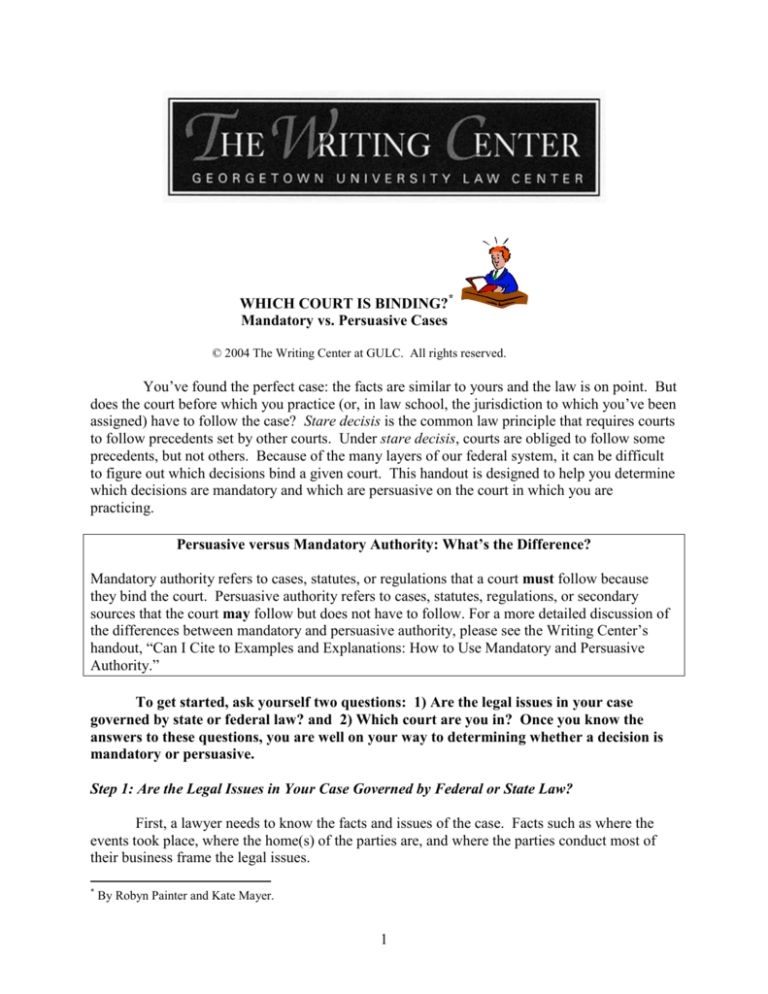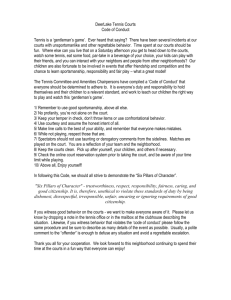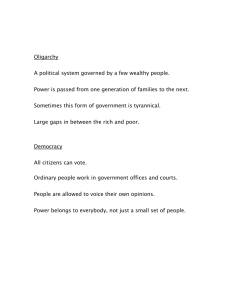
WHICH COURT IS BINDING?*
Mandatory vs. Persuasive Cases
© 2004 The Writing Center at GULC. All rights reserved.
You’ve found the perfect case: the facts are similar to yours and the law is on point. But
does the court before which you practice (or, in law school, the jurisdiction to which you’ve been
assigned) have to follow the case? Stare decisis is the common law principle that requires courts
to follow precedents set by other courts. Under stare decisis, courts are obliged to follow some
precedents, but not others. Because of the many layers of our federal system, it can be difficult
to figure out which decisions bind a given court. This handout is designed to help you determine
which decisions are mandatory and which are persuasive on the court in which you are
practicing.
Persuasive versus Mandatory Authority: What’s the Difference?
Mandatory authority refers to cases, statutes, or regulations that a court must follow because
they bind the court. Persuasive authority refers to cases, statutes, regulations, or secondary
sources that the court may follow but does not have to follow. For a more detailed discussion of
the differences between mandatory and persuasive authority, please see the Writing Center’s
handout, “Can I Cite to Examples and Explanations: How to Use Mandatory and Persuasive
Authority.”
To get started, ask yourself two questions: 1) Are the legal issues in your case
governed by state or federal law? and 2) Which court are you in? Once you know the
answers to these questions, you are well on your way to determining whether a decision is
mandatory or persuasive.
Step 1: Are the Legal Issues in Your Case Governed by Federal or State Law?
First, a lawyer needs to know the facts and issues of the case. Facts such as where the
events took place, where the home(s) of the parties are, and where the parties conduct most of
their business frame the legal issues.
*
By Robyn Painter and Kate Mayer.
1
Facts: Imagine that you are shopping in a grocery store in Virginia when a little old woman in
line at the checkout starts screaming that she’s been pick-pocketed. The police arrive on the
scene and the woman identifies you as someone who suspiciously brushed against her. The
police arrest you and throw you in jail. Later, they seek to interrogate you without informing
you of your right to have a lawyer present.
Legal Issues: Some possible legal issues raised by these facts include:
Is pick pocketing a crime in Virginia? If so, under what law?
Did the police have probable cause to arrest you based on the identification of the old
woman?
How reliable was the old lady’s identification?
How long can the police hold you?
Were any of your Constitutional rights violated during the police’s arrest and
interrogation of you?
If you are found guilty, can the little old lady also sue you in civil court for infliction of
emotional distress or another tort?
After you have brainstormed all the possible legal issues the facts raise, determine
whether the legal issues are governed by federal or state law. In any given case, there may be
both federal and state issues. America operates on a system of dual sovereignty: the 50 states
and the federal government all retain their own sovereignty. Because each state is a sovereign,
each state sets its own laws and has its own Constitution. In addition, the United States federal
government makes laws and has a Constitution.
When determining whether a legal issue is governed by federal or state law, keep in mind
that some areas of the law, such as criminal and environmental law, are governed by both state
and federal laws. Generally, the principle of preemption means that a legitimate federal action
supersedes a state law in certain cases. Although a full discussion of preemption is beyond the
scope of this handout, you should be aware of some basic principles. Federal law preempts state
law when the two laws conflict, when Congress expressly or implicitly says so, or when federal
laws are so pervasive that they occupy the entire field of law.
There is no preemption issue in your case. So, two sets of laws potentially govern:
Federal Issues: Once you were arrested, basic rights ensured by the Fourth, Fifth, and
Sixth Amendments of the Constitution came into play. These rights are ultimately
governed by federal law—the U.S. Constitution. Usually, there are state cases adopting
Federal Courts’ interpretation of the Constitution. If this is so, you should cite your state
case. Be careful, though, to check and see if there are any new federal decisions
governing basic Constitutional rights surrounding your case.
State Issues: Although there are no federal laws against pick pocketing, states and local
governments make laws for the public welfare and safety. In your case, Virginia’s or the
town’s local pick pocketing statute will lay out the elements of the offense, as well as the
punishment to be levied against such an offender. The court’s decision as to whether you
are guilty of pick pocketing will be informed by state statutes and cases about pick
2
pocketing. Remember, too, that state Constitutions also protect your rights. They must
give you at least as many rights as the Federal Constitution, but they can also entitle you
to broader protections.
Step 2: Which Court Are You In?
Determining which court you are in is a two part inquiry. First, ask yourself whether you
are in federal or state court. Dual sovereignty means that each sovereign has its own court
system: the states each have courts and the United States has courts, which are called federal
courts. Federal courts are located throughout the United States—not just in Washington, D.C.
Second, ask yourself whether you are in a trial court, a mid-level appeals court, or a
supreme court. Most American court systems—whether they are federal or state—have a similar
structure, consisting of trial courts, mid-level appeals courts, and supreme courts. In the federal
court system, the trial courts are called United States District Courts. The federal courts of
appeals each cover a geographical area called a circuit and are, accordingly, called Circuit
Courts. States vary in the names they give to their courts, but regardless of the nomenclature, the
structure is the same.
In your case, the local police arrested you. These police were acting under the authority
of the Virginia state or local statute against pick pocketing. Thus, at this point, you are in a
Virginia state trial court. Realize, though, that even though you are in a state court, the federal
Constitutional issues you identified in step 1 can still be heard by that court.
If you lose at trial and need to appeal, that appeal will go to Virginia’s mid-level court of
appeals, and then to Virginia’s highest court. Only if you lose at the state’s highest court and
believe that the state law violates the U.S. Constitution can you appeal to the U.S. Supreme
Court.
If you had been arrested by the FBI or for a federal offense, then you could be tried in
federal district court, perhaps in the U.S. District Court of the Eastern District of Virginia. If the
case were appealed, it would go to the Fourth Circuit Court of Appeals, then to the U.S.
Supreme Court.
NOW YOU’RE READY! Is the case you’ve found mandatory or persuasive?
Now that you have found a case on point, some general principles will help you to figure
out whether a law is mandatory or persuasive. Use your answers to the above questions to apply
these principles to your case.
3
First, higher courts bind lower courts within their particular state or circuit. With the
exception of the U.S. Supreme Court, courts of appeals and state courts do not bind courts
outside the state or circuit in which they are located. That is, a federal Supreme Court decision is
mandatory on all lower federal courts, both courts of appeals and district courts. A federal
circuit decision is mandatory on all federal courts within its circuit, but not federal courts in other
circuits. For example, a 9th Circuit decision binds the U.S. district courts within the 9th Circuit,
but not federal courts in any other circuit. However, a district court or trial court decision would
not bind higher courts. A state supreme court decision is mandatory on all appeals courts and
trial courts in that state, but not on state courts in other states, and a state court of appeals’
decision binds state trial courts in that state.
Second, federal courts usually bind only other federal courts, not state courts.
Similarly, state courts usually bind only other state courts. Thus, a decision by the U.S. Ninth
Circuit Court of Appeals, a federal court, mandatory on federal courts within the boundaries of
the Ninth Circuit. It is not mandatory on California state courts, even though California is
geographically within the Ninth Circuit. Similarly, a California Supreme Court decision would
bind other California state courts, but not the Ninth Circuit or other state courts (like Nevada
state courts).
Finally, federal courts bind other federal courts only when they interpret and apply
federal law while state courts bind other state courts only when they interpret and apply
state law. Sometimes a federal court must apply a state’s law. In that case, the state’s
interpretation of that law is mandatory on the federal court. Even so, the federal court can still
decide whether the state’s interpretation is consistent with federal law. Similarly, state courts
must sometimes decide issues of federal law, but they are not bound by federal courts except the
U.S. Supreme Court. The U.S. Supreme Court, a federal court, is mandatory on state courts
when it decides an issue of federal law, such as Constitutional interpretation. Other federal
courts—district and appellate—are not mandatory on state courts.
The Virginia state trial court in which your case will be heard is bound by Virginia
courts of appeal and by Virginia’s highest court on all state issues. Because the pick-pocketing
law is a state issue, the state’s courts of appeals and state supreme court decisions will bind the
state trial court you are in. In contrast, the Constitutional issues are federal. The state trial
court is not bound by the state’s higher courts on these federal issues. Rather, it is bound by the
U.S. Supreme Court’s decisions about fundamental rights. Although a State Constitution will
also grant these rights, no state can guarantee less protection than the Federal Constitution.
If you had been accused of a federal offense, you probably would have appeared in a
Federal District Court, which would have been bound by the court of appeals for your Circuit,
and the Supreme Court on all federal issues. However, Virginia state courts’ decisions would
still have governed state issues in federal court.
Applying this analysis from the outset will help you to be a smarter, faster researcher and
to narrow down the body of case law that you are looking at. Knowing what the court is bound
to follow will help you to write more persuasive memos, motions, and briefs.
4
For further reading, see The Legal Research Manual, Christopher G. Wren and Jill Robinson
Wren or Finding the Law, Robert C. Berring and Elizabeth A. Edinger.
This chart displays the above principles in another form. Use your answers to questions 1
and 2—whether the issue is state or federal and which court you are in—to find the box in the
1) State or Federal Issue?
2) Which court are you in?
State issue in state trial court
Binding Authority
Persuasive Authority
That state’s state appeals court
That state’s highest court
State issue in state appeals court
That state’s highest court
State issue in state’s highest court
That state’s highest court
Federal issue in state trial court
US Supreme Court
Federal issue in state appeals court
US Supreme Court
Federal issue in state supreme court
US Supreme Court
State issue in federal district court
Interpretations from the state’s
highest court
Interpretations from the state’s
highest court
Interpretations from the state’s
highest court
US Supreme Court
Federal circuit court in the circuit
where the district court is
That federal circuit court
US Supreme Court
All federal courts
Other states’ state courts
Other state trial courts in the same
state
All federal courts
Other states’ state courts
State trial courts in the same state
Other state courts of appeals in the
same state
All federal courts
Other states’ state courts
State trial courts in the same state
State courts of appeals in the same
state
All federal district courts
All federal circuit courts
State courts
All federal district courts
All federal circuit courts
State courts
All federal district courts
All federal circuit courts
State courts
All federal courts
Other state courts
All federal courts
Other state courts
All federal courts
Other state courts
Other federal circuit courts
Other federal district courts
All state courts
Other federal circuit courts
Other federal district courts
All state courts
All federal circuit courts
All federal district courts
All state courts
State issue in federal circuit court
State issue in U.S. Supreme Court
Federal issue in federal district court
Federal issue in federal circuit court
Federal issue in US Supreme Court
US Supreme Court
left hand column that applies to your case. Then, read across that row to find out which courts
bind you and which courts are only persuasive to you.
5










